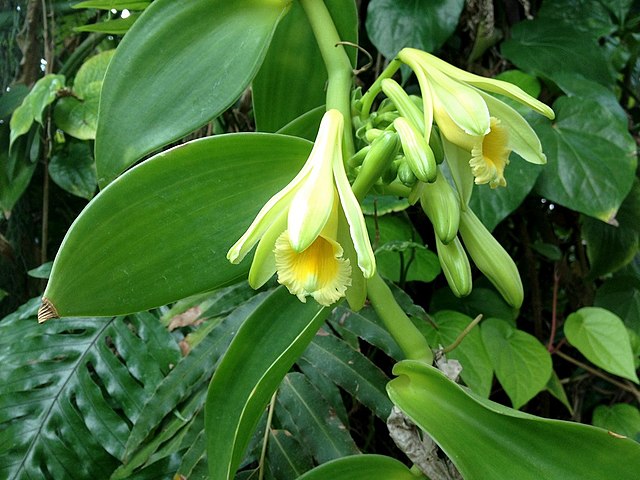Vanilla
Vanilla planifolia
Family: Orchidaceae | Place of Origin: Madagascar, Central America
Origins and history:
Vanilla is believed to have originated from Mesoamerica, which is the region of common day Central America. The Totonac people of Papantla were the first group to cultivate vanilla, and it played a huge role in their culture (Lubinsky et. al. 2008). In the 18th century, this region became the first and only to produce vanilla for the international market. Europe was the primary market for vanilla, where the flavor was used for mostly making of sweets (Bruman 1948). In the 19th century French colonies boomed in vanilla production, and Madagascar became the major supplier of vanilla and is to this day.

Identification characteristics
- Leaves: The leaves grow in an alternate arrangement along the entirety of the vine and are fleshy in nature, much like a succulent. The leaves are about 20 cm long and 8 cm wide and are oblong to lanceolate in shape.
- Flowers and Fruit: The flowers are a yellowish/green color and are about 5 cm in diameter. The plant is unique in its flowering characteristics. Each inflorescence gives rise to only one flower at any one time, and this flower only lasts a single day, sometimes even less. If the flower is not pollinated in this time, it is simply dropped by the plant the next day. Pollination results in the development of fruit, which are slender green pods about 6 to 9 inches in length. It is these pods that make vanilla such a valuable commodity.
- Height: The plants themselves can grow up to a staggering 75 feet tall in the wild, but grow much shorter in farms, around 8 to 10 feet in height. To support themselves at such staggering heights, the plants send out aerial roots to attach themselves to surfaces and allow for continued growing.
- Size and Habitat: This orchid is terrestrial and has a vine-like form, like all other orchids in the genus Vanilla. Vanilla is an epiphytic plant, meaning that it utilizes other plants to grow on and support itself without causing harm to these other plants.
- Scent: The scent of Vanilla planifolia is quite surprising, as there is not much of a scent at all. The flower itself produces little to no scent, and it is actually the pod that produces these aromatic compounds. However, this is only after curing the pods. The scent of the vanilla pod after curing is exactly what one might expect. It is a creamy, warm, and soothing smell that is widely sought after and used in numerous different products.
Uses and preparation
Vanilla must undergo an extensive process to become suitable for market consumption. It first must be harvested off the plant, at which point the pod is green and lacks flavor and aroma. The pods must then be killed to prevent further ripening. The pods can then begin their curing process, which can take up to months to complete. After vanilla is cured, it is most used as an extract or a concentrate. Vanilla can be found in numerous foods and is an essential component of many sweets. Along with food uses, vanilla is used for its scent in many colognes, perfumes, and other household items like candles and soaps.